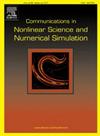求解时变复数Sylvester方程的一种新的定时ZNN及其在伪逆中的应用
IF 3.8
2区 数学
Q1 MATHEMATICS, APPLIED
Communications in Nonlinear Science and Numerical Simulation
Pub Date : 2025-06-11
DOI:10.1016/j.cnsns.2025.109021
引用次数: 0
摘要
本文创新性地设计了一种新的规定时间归零神经网络(ZNN)模型来求解时变复杂Sylvester (TVCS)方程,并将其实现嵌入到矩阵的伪逆环境中。通过在激活函数中加入三角函数项,所提出的规定时间ZNN模型能够在预定的时间框架内实现零收敛。利用我们的规定时间ZNN模型,可以在规定时间内得到TVCS方程的解。此外,我们提出的ZNN的鲁棒性通过加入较大的模型实现误差来证明。此外,利用一个伪逆问题来证明我们所提出的网络模型的有效性。此外,本文还提供了对参数敏感性的见解和参数选择策略的概述,这两者都通过数值模拟得到了严格的验证。本文章由计算机程序翻译,如有差异,请以英文原文为准。
A novel prescribed-time ZNN for solving time-varying complex Sylvester equation and application to pseudo-inverse
This paper innovatively designs a novel prescribed-time zeroing neural network (ZNN) model to solve the time-varying complex Sylvester (TVCS) equation, with its implementation embedded within the context of the pseudo-inverse of a matrix. By incorporating a trigonometric function term into the activation function, the proposed prescribed-time ZNN model is capable of achieving zero convergence within a predetermined time frame. The solution to the TVCS equation can be obtained within this prescribed time using our prescribed-time ZNN model. In addition, the robustness of our proposed the ZNN is shown by adding a large model-implementation error. Furthermore, a pseudo-inverse problem is utilized to demonstrate the efficacy of our proposed network model. Additionally, the paper provides insights into the parameter sensitivity and outlines strategies for parameter selection, both of which have been rigorously validated through numerical simulations.
求助全文
通过发布文献求助,成功后即可免费获取论文全文。
去求助
来源期刊

Communications in Nonlinear Science and Numerical Simulation
MATHEMATICS, APPLIED-MATHEMATICS, INTERDISCIPLINARY APPLICATIONS
CiteScore
6.80
自引率
7.70%
发文量
378
审稿时长
78 days
期刊介绍:
The journal publishes original research findings on experimental observation, mathematical modeling, theoretical analysis and numerical simulation, for more accurate description, better prediction or novel application, of nonlinear phenomena in science and engineering. It offers a venue for researchers to make rapid exchange of ideas and techniques in nonlinear science and complexity.
The submission of manuscripts with cross-disciplinary approaches in nonlinear science and complexity is particularly encouraged.
Topics of interest:
Nonlinear differential or delay equations, Lie group analysis and asymptotic methods, Discontinuous systems, Fractals, Fractional calculus and dynamics, Nonlinear effects in quantum mechanics, Nonlinear stochastic processes, Experimental nonlinear science, Time-series and signal analysis, Computational methods and simulations in nonlinear science and engineering, Control of dynamical systems, Synchronization, Lyapunov analysis, High-dimensional chaos and turbulence, Chaos in Hamiltonian systems, Integrable systems and solitons, Collective behavior in many-body systems, Biological physics and networks, Nonlinear mechanical systems, Complex systems and complexity.
No length limitation for contributions is set, but only concisely written manuscripts are published. Brief papers are published on the basis of Rapid Communications. Discussions of previously published papers are welcome.
 求助内容:
求助内容: 应助结果提醒方式:
应助结果提醒方式:


